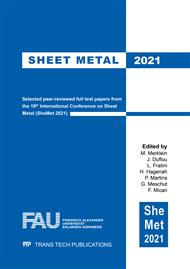p.119
p.127
p.135
p.143
p.151
p.159
p.167
p.175
p.181
Assessment of Springback Behaviour of 800-1200 MPa Dual-Phase Steel Grades
Abstract:
Springback occurs in sheet metal forming due to elastic strain recovery after removal of process forces respectively after opening of the tool. For this reason, a precise description of springback requires the elastic stress-strain relationship described by the Young’s modulus as well as the internal stress distribution of the part before unloading. In this context, the Bauschinger effect influences the stress state before springback due to premature plastification during load reversal or load path change. As is well known, the stress-strain curve of a material during unloading is non-linear because of additional microplastic strain, which is reflected in a decrease of the Young’s modulus. The aim of this work is to characterize the aforementioned phenomena and their effect on springback for three dual-phase steels namely DH800, DH1000 and DP1200LY. For this purpose, cyclic tensile-compression tests as well as loading and unloading loops within uniaxial tensile tests are performed at different plastic strains. To evaluate the springback behavior of the investigated materials, two different hat-profiles geometries are investigated. By comparing the springback of dual-phase steels on part level, the significance of different material influences with regard to springback is evaluated. The results show that the investigated dual-phase steels exhibit a pronounced Bauschinger effect and a considerable amount of microplastic strain with increasing total strain. However, the comparison between the springback of the hat-profiles and the determined material parameters proves a significant influence of the elastic strain on springback, while microplastic strain and the Bauschinger effect have a minor influence.
Info:
Periodical:
Pages:
151-158
Citation:
Online since:
April 2021
Authors:
Keywords:
Price:
Сopyright:
© 2021 Trans Tech Publications Ltd. All Rights Reserved
Share:
Citation:


